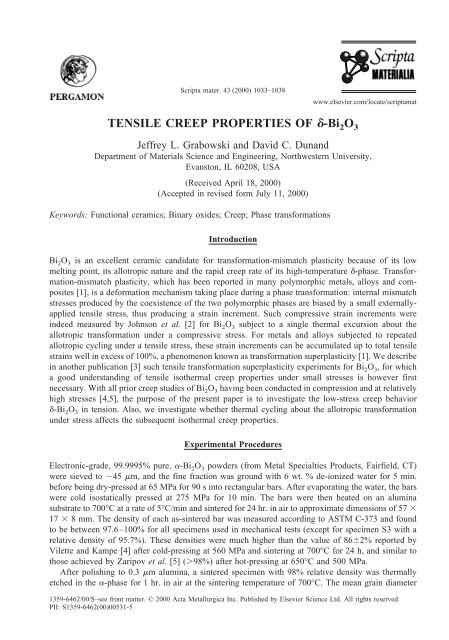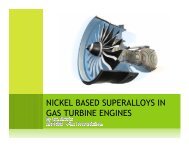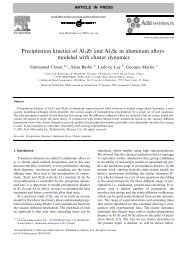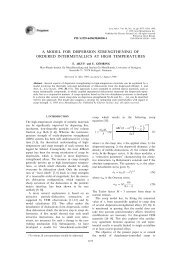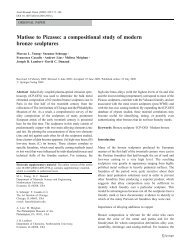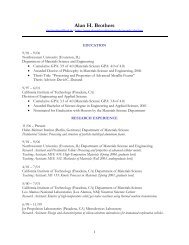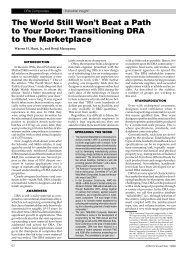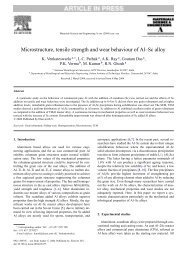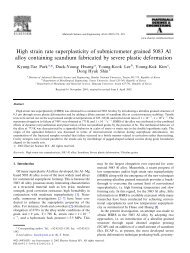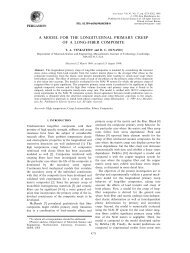TENSILE CREEP PROPERTIES OF -Bi - David Dunand Research ...
TENSILE CREEP PROPERTIES OF -Bi - David Dunand Research ...
TENSILE CREEP PROPERTIES OF -Bi - David Dunand Research ...
Create successful ePaper yourself
Turn your PDF publications into a flip-book with our unique Google optimized e-Paper software.
Scripta mater. 43 (2000) 1033–1038www.elsevier.com/locate/scriptamat<strong>TENSILE</strong> <strong>CREEP</strong> <strong>PROPERTIES</strong> <strong>OF</strong> -<strong>Bi</strong> 2 O 3Jeffrey L. Grabowski and <strong>David</strong> C. <strong>Dunand</strong>Department of Materials Science and Engineering, Northwestern University,Evanston, IL 60208, USA(Received April 18, 2000)(Accepted in revised form July 11, 2000)Keywords: Functional ceramics; <strong>Bi</strong>nary oxides; Creep; Phase transformationsIntroduction<strong>Bi</strong> 2 O 3 is an excellent ceramic candidate for transformation-mismatch plasticity because of its lowmelting point, its allotropic nature and the rapid creep rate of its high-temperature -phase. Transformation-mismatchplasticity, which has been reported in many polymorphic metals, alloys and composites[1], is a deformation mechanism taking place during a phase transformation: internal mismatchstresses produced by the coexistence of the two polymorphic phases are biased by a small externallyappliedtensile stress, thus producing a strain increment. Such compressive strain increments wereindeed measured by Johnson et al. [2] for <strong>Bi</strong> 2 O 3 subject to a single thermal excursion about theallotropic transformation under a compressive stress. For metals and alloys subjected to repeatedallotropic cycling under a tensile stress, these strain increments can be accumulated up to total tensilestrains well in excess of 100%, a phenomenon known as transformation superplasticity [1]. We describein another publication [3] such tensile transformation superplasticity experiments for <strong>Bi</strong> 2 O 3 , for whicha good understanding of tensile isothermal creep properties under small stresses is however firstnecessary. With all prior creep studies of <strong>Bi</strong> 2 O 3 having been conducted in compression and at relativelyhigh stresses [4,5], the purpose of the present paper is to investigate the low-stress creep behavior-<strong>Bi</strong> 2 O 3 in tension. Also, we investigate whether thermal cycling about the allotropic transformationunder stress affects the subsequent isothermal creep properties.Experimental ProceduresElectronic-grade, 99.9995% pure, -<strong>Bi</strong> 2 O 3 powders (from Metal Specialties Products, Fairfield, CT)were sieved to 45 m, and the fine fraction was ground with 6 wt. % de-ionized water for 5 min.before being dry-pressed at 65 MPa for 90 s into rectangular bars. After evaporating the water, the barswere cold isostatically pressed at 275 MPa for 10 min. The bars were then heated on an aluminasubstrate to 700°C at a rate of 5°C/min and sintered for 24 hr. in air to approximate dimensions of 57 17 8 mm. The density of each as-sintered bar was measured according to ASTM C-373 and foundto be between 97.6–100% for all specimens used in mechanical tests (except for specimen S3 with arelative density of 95.7%). These densities were much higher than the value of 862% reported byVilette and Kampe [4] after cold-pressing at 560 MPa and sintering at 700°C for 24 h, and similar tothose achieved by Zaripov et al. [5] (98%) after hot-pressing at 650°C and 500 MPa.After polishing to 0.3 m alumina, a sintered specimen with 98% relative density was thermallyetched in the -phase for 1 hr. in air at the sintering temperature of 700°C. The mean grain diameter1359-6462/00/$–see front matter. © 2000 Acta Metallurgica Inc. Published by Elsevier Science Ltd. All rights reserved.PII: S1359-6462(00)00531-5
1034 <strong>CREEP</strong> <strong>PROPERTIES</strong> <strong>OF</strong> DELTA-<strong>Bi</strong> 2 O 3Vol. 43, No. 11of as-sintered -<strong>Bi</strong> 2 O 3 was 13 m, somewhat larger than the 9 m value reported in Ref. [4,5]. Thesintered bars were machined into flat tensile specimens with overall dimensions of 50.1 16.7 2.5mm and with a gage section 16.7 mm long and 4.6 mm wide. The radius at the end of the gage was small(less than 1 mm). Every surface was hand-polished with 600 grit SiC paper to remove any small chipsincurred during machining and ultrasonically cleaned in acetone prior to testing.Two types of mechanical tests were used. A first series of tests (denominated S in the following)were conducted on a servo-mechanical MTS machine operated under constant tensile load conditionswhere the elongation of specimens was determined from cross-head displacement and temperature wasmeasured with a thermocouple at the gauge length. After soaking at the test temperature of 7605°Cfor 10 min., the load was applied and a minimum creep rate was measured on each of six specimens(S1-S5, S7) at a constant tensile stress in the range of 0.09–0.78 MPa. Specimens were subsequentlycycled about the transformation range under load, as reported in more detail in Refs. [3,6]. Onespecimen (S6) was subjected to increasing stress values from 0.14 MPa to 0.78 MPa at 760°C todetermine the stress exponent n. Subsequently, specimen S6 was tested again at a lower stress of 0.30MPa, thermally cycled 10 times under that stress, and then crept at 760°C at 0.36 MPa.A dead-load tensile creep apparatus was used for 8 additional isothermal and cycling specimenswhich are denominated C in the following. Specimen elongation was measured from load-train traveloutside the hot zone and specimen temperature was determined with a thermocouple at the center of thegauge length. Two tests were carried out at a tensile stress of 0.30 MPa and increasing temperatures(710–760°C for specimen C5 and 680–740°C for specimen C6) to determine a creep activation energy.To insure that these specimens were in the -phase during the creep tests, they were first heated underminimal load to 760°C then cooled to the lowest temperature of the test while still in the -phase.Furthermore, six creep specimens (C1-C4, C7-C8) were tested in air at 7605°C at one or two tensilestress values in the range of 0.10–0.50 MPa and were subsequently subjected to thermal cycling underload about the allotropic temperature [3,6]. Except for specimens C1 and C4, fracture occurred beforepost-cycling creep could be measured. The pre- and post-cycling creep rates of specimen C1 weremeasured after 6 cycles at 0.11 MPa and 10 cycles at 0.21 MPa, both between 595 and 755°C.Post-cycling creep was measured in specimen C4 after 6 cycles at 0.31 MPa between 600 and 760°C.Results and DiscussionAfter mechanical loading, a primary creep region was observed where the strain-rate decreasedsmoothly over a strain of about 0.3–0.8%. Subsequently, a secondary creep regime characterized by asteady-state, minimum creep rate was established over a strain of about 1.5–4%. Figure 1a shows adouble logarithmic plot of the minimum strain-rate ˙ at 760°C as a function of the stress , accordingto the power-law creep equation:˙ K n exp Q RT (1)where K is a constant, n the stress exponent, Q the activation energy, R the gas constant and T theabsolute temperature. An average stress exponent n 1.3 is determined from a best-fit line in Fig. 1a,which also shows a band corresponding to a deviation by 50% from the best-fit line, correspondingto the typical creep experimental error expected at low stresses [7]. According to Eq. (1), Fig. 1b givesthe temperature dependence of the minimum strain rate for specimens C5 and C6, from which activationenergies of 200 kJ/mol and 130 kJ/mol respectively are calculated, with an average value of 165 kJ/mol.For this average activation energy, the power-law constant determined from data in Fig. 1a has a valueof K 6.0 10 3 MPa 1.3. s 1 .
Vol. 43, No. 11<strong>CREEP</strong> <strong>PROPERTIES</strong> <strong>OF</strong> DELTA-<strong>Bi</strong> 2 O 3 1035Figure 1. a. Plot of strain rate vs. stress for -<strong>Bi</strong> 2 O 3 at 760°C showing an average stress exponent n 1.3. Dotted bandcorresponds to a typical creep error of 50% from the best-fit solid line. b. Logarithmic plot of strain rate vs. inverse temperaturefor -<strong>Bi</strong> 2 O 3 at 0.3 MPa, yielding activation energies Q 200 and 130 kJ mol 1 for specimens C5 and C6, respectively.We are only aware of two studies of the high-temperature creep behavior of <strong>Bi</strong> 2 O 3 under isothermalconditions. First, Zaripov et al. [5] measured the compressive flow stress of -<strong>Bi</strong> 2 O 3 at 650°C underconstant strain rates in the range of 6 10 5 –5 10 3 sec 1 and for stresses in the range 8–30 MPa.In the low strain-rate region, they measured a stress exponent of about 2.5 and large compressive strainson the order of 75%. Examination of the samples after deformation indicated that the equiaxed grainswere stable, the texture was decreased and grain boundary sliding was the dominant deformationmechanism. Based on these features, they identified the deformation mechanism of -<strong>Bi</strong> 2 O 3 asmicrostructural superplasticity. In contrast to the above results, Vilette and Kampe [4] found that-<strong>Bi</strong> 2 O 3 deformed in compression only 1% before cracking at 700°C, which may have been due to thelarger amount of porosity of their specimens. However, these authors found that -<strong>Bi</strong> 2 O 3 exhibitedextensive compressive ductility under constant strain rate conditions. They reported stress exponentsand activation energies from creep in the stress range 0.6–2.5 MPa and temperature range of750–800°C.Figure 2 shows our tensile creep data plotted together with the compressive creep data of Vilette andKampe [4]. Our highest stress at 760°C (0.8 MPa) is very close to their lowest stress at 750°C (0.95MPa), and the discrepancy in strain rate for these two data points is about a factor 4, somewhat largerthan the typical scatter in our data. We note that Vilette and Kampe’s specimens exhibited high porosity(14%, as compared to our values which are less than 2.4%), so that densification could have contributedFigure 2. Double logarithmic plot of strain rate vs. stress for -<strong>Bi</strong> 2 O 3 at 760°C (from Fig. 1a) and at 750–800 °C (from Viletteand Kampe [4]).
1036 <strong>CREEP</strong> <strong>PROPERTIES</strong> <strong>OF</strong> DELTA-<strong>Bi</strong> 2 O 3Vol. 43, No. 11to their measured compressive strain rate. Also, our experiments were conducted under constant load,while they used constant strain-rate conditions and observed some strain-hardening. Nevertheless, Fig.2 shows that the two sets of data are mutually consistent if a change of stress exponent occurs at about0.5–0.8 MPa. The stress exponent n 3.3 for the data of Vilette and Kampe at higher stresses(0.95–2.5MPa) is indicative of dislocation creep, as originally suggested by these authors. Using ourdata point up to 0.5 MPa (and thus neglecting our four highest stress points in the transition range of0.5–0.8 MPa), the best-fit slope gives a stress exponent n 1.0, suggestive of diffusional creep orgrain-boundary sliding. For comparison purpose in the following, it is mathematically more convenient(and statistically as accurate) to describe the whole data set (0.1–0.8 MPa) with a single stress exponentn 1.3, rather than using n 1.0 for 0.1–0.5 MPa and n 3.3 for 0.5–0.8 MPa. Together with varyinginitial porosity and cracking which are discussed later, different initial grain sizes in the -phase cancontribute to the relatively high sample-to-sample variability observed in our creep data; this is becausethe diffusional creep regime, unlike the dislocation creep regime, is sensitive to grain size. We note thatwhile the grain size in the -phase cannot be observed at room temperature, it can be expected to becomparable to the measured -phase value of 13 m, since grain growth is inhibited by pores whichdictate the steady-state grain size. However, variations in porosity among specimens may have lead tovariations in grain sizes for both - and -phases.Vilette and Kampe [4] determined activation energies from two sets of experiments at 775°C and800°C over a stress range from 0.5 MPa to 3.0 MPa, and reported values decreasing with stress fromabout 250 to about 210 kJ/mol. Given their small temperature range of 25 K, these values are inreasonable agreement with our specimen C5 (Q 200 kJ/mol, Fig. 1b), measured over 50 K for a stressof 0.3 MPa. There is however a significant discrepancy with specimen C6 (Q 130 kJ/mol, Fig. 1b),which also shows a strain rate lower by a factor of about 4 as compared to specimen C5 at the samenominal stress of 0.3 MPa. Again, it is possible that the differences in both activation energies and strainrates between specimens C5 and C6 in Fig. 1b may be due to variations in -<strong>Bi</strong> 2 O 3 grain sizes, leadingto different contributions from the two deformation mechanisms. Cracking may also have occurred inspecimen C5 because of higher porosity levels and contributed to the measured strain rate, as discussedin more detail later. Creep is expected to be controlled by the self-diffusion of <strong>Bi</strong> 3 , because oxygenanions have a much higher mobility than bismuth cations in -<strong>Bi</strong> 2 O 3 . An Arrhenius plot of bismuthself-diffusion coefficient (measured by Palkar et al. [8] at 700°C, 750°C and 780°C on pressed andsintered pellets of -<strong>Bi</strong> 2 O 3 ) gives an activation energy of 160 kJ/mol in good agreement with ouraverage activation energy for creep.When characterizing a metallic system for creep at low strain rates, typical experimental error onstrain rates is 50%, which can be subdivided roughly equally between errors in testing parameters(e.g., temperature and stress) and errors due to microstructural differences from specimen to specimen[7]. The latter effect is expected to be more important in ceramics than in metals because of therelatively large residual porosity and high brittleness of ceramics. Higher porosity is expected to leadto higher creep rates both directly (by reducing the load-bearing area of the specimen) and indirectly(by increasing the propensity for cracking and by reducing the grain size). The effect of initial porosityis illustrated in Fig. 3a which shows that the seven samples with a high porosity (arbitrarily chosen aslarger than 0.5%) all exhibited creep rates higher than the best fit line. Eliminating from the data setthose seven specimens gives a stress exponent n 1.2 which is only slightly smaller than the value ofn 1.3 calculated taking all data into account. Similarly, the predicted magnitude of the strain rate isdecreased only by a small amount (10–30%) in the stress range of interest.Also shown in Fig. 3a are the six data points (crossed symbols) collected on the same specimen (S6)under conditions of increasing applied stress, except for the second point near 0.3 MPa which wascollected last. Ignoring the point at the highest stress where dislocation creep may be active (Fig. 2),these data points show a stress exponent n 1.4, close to the expected value, and are shifted to the
Vol. 43, No. 11<strong>CREEP</strong> <strong>PROPERTIES</strong> <strong>OF</strong> DELTA-<strong>Bi</strong> 2 O 3 1037Figure 3. a. Comparison of strain rates for initial specimen relative density above and below 99.5%. Crossed symbols correspondto multiple tests on the same specimen (S6). b. Comparison of strain rates for tests C1, C4 and S6 conducted before and afterthermal cycling about the phase transformation of <strong>Bi</strong> 2 O 3 .lower range of creep rate, as expected from the low 0.1% porosity of that specimen. This indicates thatonce the -<strong>Bi</strong> 2 O 3 grain size had been established after the phase transformation, subsequent graingrowth or recrystallization (which were suspected to occur in the study of Vilette and Kampe [4]) hadno significant effect for the low range of stresses in the present study (specimen S6 was tested for thelongest time in the present study). Finally, the higher strain rates previously noted in specimen C5 ascompared to specimen C6 (Fig. 1b) also correlate with the different porosities of these two specimens(97.9% and 99.1%, respectively, Fig. 3a). The activation energy determined from the denser specimenC6 (Q 130 kJ/mol) is thus probably more accurate than that for specimen C5 (Q 200 kJ/mol).Figure 3b shows a comparison of creep rates before and after thermal cycling in specimens C1, C4and S6, which are discussed in detail in the following. For specimen C1, the post-cycling creep rate after6 thermal cycles at 0.11 MPa (point (b) in Fig. 3b) was three times slower than the pre-cycling rate(point (a)). One explanation may be that a steady-state creep rate had not yet been achieved beforecycling (point (a)). Subsequent deformation during thermal cycling at 0.11 MPa allowed the specimento progress from the primary to the secondary creep regime, leading to a lower post-cycling creep (point(b)). Another explanation is that the -<strong>Bi</strong> 2 O 3 grain size was larger after thermal cycling, thus loweringthe strain rate. Point (c) shows the strain rate after the stress was increased to 0.21 MPa. After 10thermal cycles, the stress had increased to 0.23 MPa due to area reduction, and the post-cycling creeprate at point (d) was somewhat higher than expected. While the rate increase from point (c) to point (d)is well within experimental error, cracks observed along the gauge length after cycling may havecontributed to the faster deformation. The pre-cycling creep of specimen C4 (point (e)) is close to thebest-fit line prediction. After 6 thermal cycles, the stress increased due to reduced cross-section and thestrain rate correspondingly increased to point (f), as expected from the best-fit stress exponent.Similarly, for specimen S6, the increase in stress after 10 cycles lead to an increase in strain rate frompoint (g) to point (h) which was only slightly higher than predicted by the best-fit stress-exponent. Forthis specimen too, a crack was observed in the gauge length after cycling, leading to fracture shortlyafter post-cycling creep was achieved.In summary, while thermal cycling can produce cracking and possibly grain size changes in -<strong>Bi</strong> 2 O 3 ,the four cycling experiments shown in Fig. 3b indicate that there is no significant change, withinexperimental error, in creep properties as a result of thermal cycling. This is further illustrated bycalculating a linear fit in Fig. 3b to all creep data except post-cycling creep: the stress exponent isunchanged at n 1.3 for all data, and the best-fit line is only slightly shifted to higher strain rates. Theseobservations are in disagreement with Johnson et al. [2] who reported that both the - and -phasesexhibited large drops in isothermal compressive creep rates after thermal cycling about the phase
1038 <strong>CREEP</strong> <strong>PROPERTIES</strong> <strong>OF</strong> DELTA-<strong>Bi</strong> 2 O 3Vol. 43, No. 11transformation. A possible explanation is that densification and/or grain growth occurred in theirexperiments.ConclusionsIsothermal tensile creep tests were performed on -<strong>Bi</strong> 2 O 3 (with an initial grain size of 13 m inthe-phase) in the stress range of 0.1–0.8 MPa.● A stress exponent of n 1.3 is measured at 760°C in the stress range of 0.1–0.8 MPa or n 1.0in the range of 0.1–0.5 MPa. A stress exponent of n 2.9–3.3 was reported by Vilette and Kampe[4] for compressive creep data at a somewhat higher stress range of 0.6–3 MPa and over atempe-rature range 750–800°C. Together with our data points in the range 0.5–0.8 MPa, thissuggests that -<strong>Bi</strong> 2 O 3 transitions from a low-stress deformation regime (diffusional creep and/orgrain-boundary sliding) to a high-stress regime (dislocation creep) at a stress of about 0.5–0.8 MPa.● An average activation energy of Q 165 kJ/mol is determined from two experiments in the rangeof 680–760°C for a stress of 0.30 MPa. This value is lower than that reported in the dislocation-creepregime (Q 210–250 kJ/mol [4]) but similar to the activation energy of self-diffusion for <strong>Bi</strong> 3 (Q 160 kJ/mol [8]).● Significant scatter exists in the measured creep rates and may be due to sample-to-sample variationin initial -<strong>Bi</strong> 2 O 3 grain sizes (important in diffusional creep) and in the density of cracks and pores(important for tensile tests). Specimens with higher initial porosity were indeed found to deform athigher rates than average.● Creep rates before and after multiple thermal cycles about the allotropic range under stress werealtered only slightly, indicating that microstructural changes due to cycling (cracking, grain growthand recrystallization) are negligible within experimental error.AcknowledgmentsThis research was sponsored by the Army <strong>Research</strong> Office (Contract Number DAAH004-95-1-0629).References1. D. C. <strong>Dunand</strong>, in International Conference on Thermomechanical Processing of Steels and Other Materials, pp. 1821–1830TMS, Warrendale, PA (1997).2. C. A. Johnson, R. C. Bradt, and J. H. Hoke, J. Am. Ceram. Soc. 58, 37 (1975).3. D. C. <strong>Dunand</strong>, and J. L. Grabowski, J. Am. Ceram. Soc. accepted for publication.4. A. Vilette and S. L. Kampe, J. Mater. Res. 11, 1433 (1996).5. N. G. Zaripov, O. A. Kalibyshev, and O. M. Kolnogorov, Phys. Solid State. 35, 1051 (1993).6. J. L. Grabowski, M.S. Thesis, Northwestern University (1998).7. M. S. Loveday, in Characterisation of High-Temperature Materials—Mechanical Testing, ed. I. Curbishley, pp. 43–107,Institute of Metals, London (1988).8. G. D. Palkar, D. N. Sitharamarao, and A. K. Dasgupta, Trans. Farad. Soc. 59, 2634 (1963).


